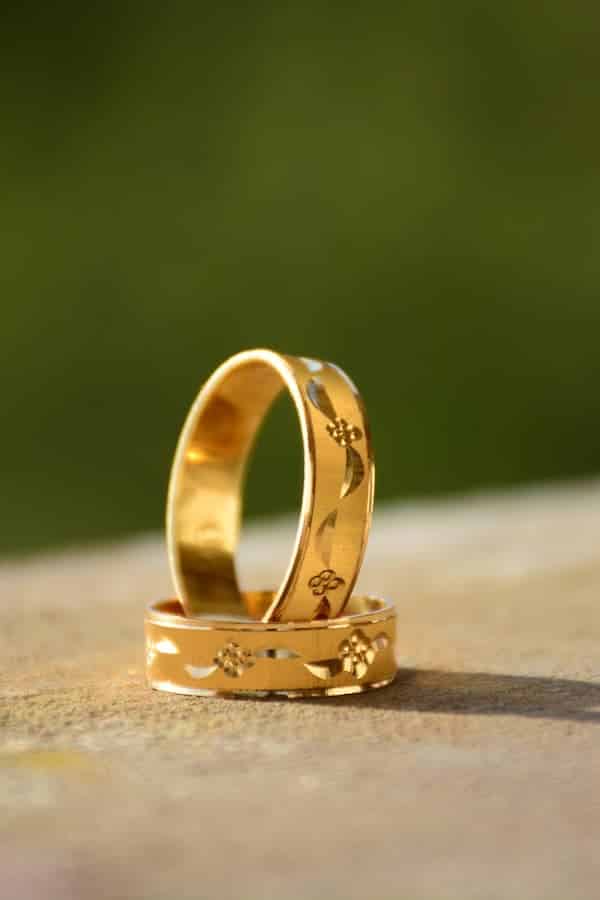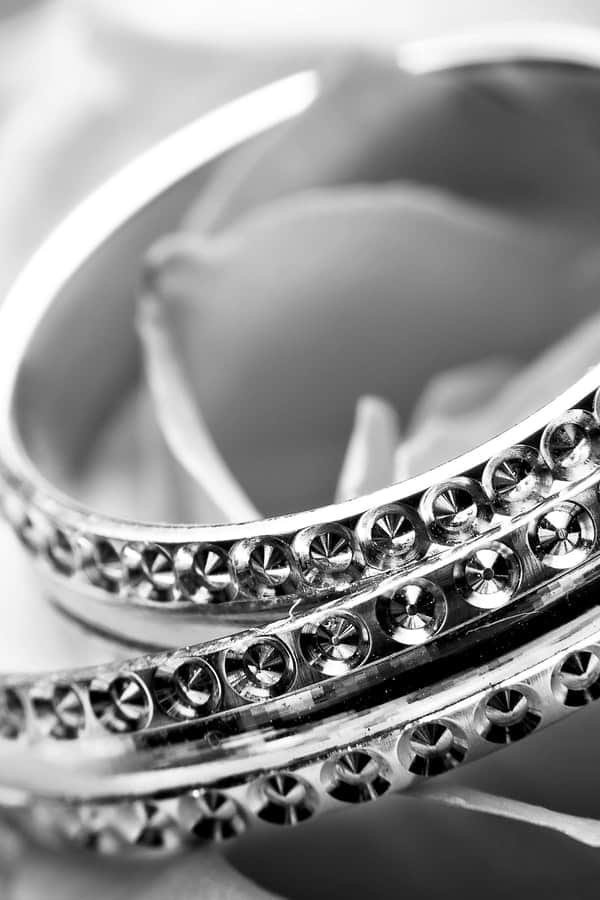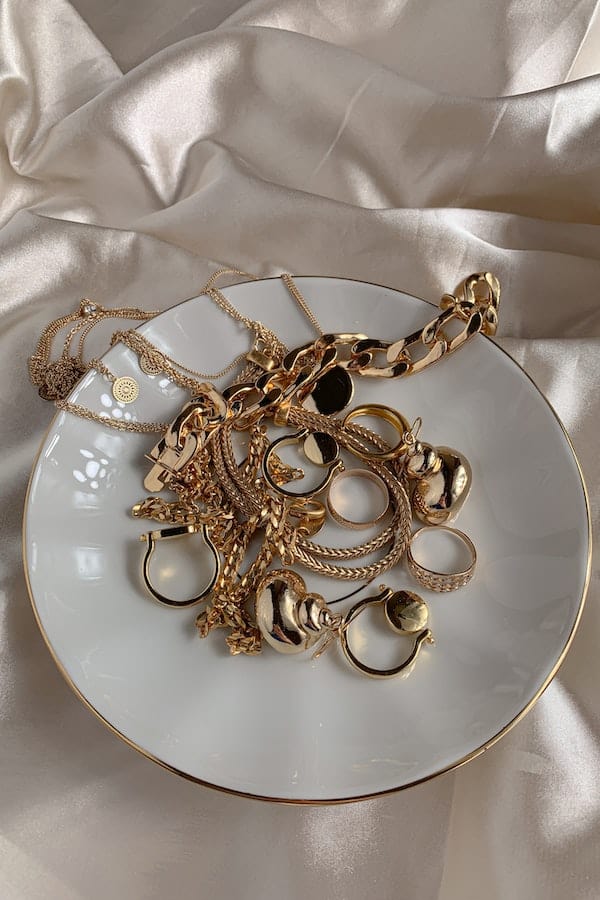You look at your gold jewelry and it doesn’t seem to have the luster that it once did. But don’t despair.
When it comes to restoring the glory of your gold, there are several ways you can choose from: a polishing cloth, creams, or humble dish soap are effective methods.
In this guide, we will run you through how to polish your gold. Also, you will discover how to buff out those scratches in the jewelry.
Preventing your gold from tarnishing is the best way to keep it shining. We’ll give you tips on how to protect your precious jewelry so that it remains looking awesome.
Ready to give your gold a polish? Read on to find out how.
There may be affiliate links in this article. You can read more about this in my disclosure.
Why does gold tarnish?

Your gold jewelry can get discolored due to several reasons:
- The quality of the gold
- the alloys mixed with it in your jewelry
- your daily routines
- and fluids from your body.
Gold in its purest form (that is,24 karat gold) is highly resistant to oxidation and other factors that can cause it to change color. Yet, 24 karat gold is soft and not that useful for making jewelry with (unless you want to have a ring or necklace that will wear away after some use).
To harden the gold, alloys such as bronze or zinc are added to it. It is these elements that are affected by exposure to the air and your body.
The lower the karat rating of the gold, the more it is going to react and show signs of tarnishing.
Any gold that rates below 14 karats is going to discolor quickly. 18 karat gold is hardier against discoloration.
Housework and your daily life
If you wear your jewelry (rings and bracelets in this case) while doing your dishes or cleaning the bathroom, the chemicals from the cleaning products can react with the gold.
The same goes with if you don’t take off your gold jewelry when you’re showering or having a bath. The soap can affect your precious bling.
Perfume, body lotion, hair spray, and cosmetics also can make your gold go from yellow to a brownish color.

Another contributor to the tarnishing of your gold is…you.
The sweat and PH levels from your body can cause your gold to tarnish.
If you want your jewelry to maintain that golden color that you adore, take it off whenever:
- you do any housework
- strenuous exercise that has you building up a sweat
- when you are having a shower/bath.
- swimming in a pool or the ocean (chemicals and salt aren’t good friends to gold).
How do I polish gold?
Polishing gold with a cloth
You can buy polishing clothes at supermarkets, hardware stores, or even at your local jewelers. The ideal type of cloth to use has two sides (or two cloths sewn together).
[amazon box=”B01N4NYU91″ template=”vertical”]Read the instructions that come with the cloth. These will tell you what each side of the cloth is used for.
Typically one side removes the tarnish and polishes the jewelry. The other side will be for a final finishing touch.
To polish your gold using a cloth the steps are usually as follows:
- Place the jewelry into the polishing cloth.
- Gently rub the cloth over the jewelry to remove any tarnish. You may find that the cloth is getting dirty as the tarnish is taken off.
- Give your jewelry the finishing touch by placing it in the secondary cloth. Rub your jewelry to give it that final gleam.
Using dish soap to polish gold
To give your gold the TLC it needs with this method you will need:
- a small bowl (big enough to place your jewelry into)
- a soft-bristled brush
- drying cloth
- water
- dish soap
- baking soda (optional)
Here is how to polish your gold using dish soap:
- Fill your bowl with lukewarm water. (Water that is too hot can damage any gemstones that may be included in the jewelry)
- Add several drops of dish soap into the water. Mix together.
- Gently place your jewelry into the solution.
- Use your brush to carefully scrub over the piece. Make sure you get into any crevices and gaps.
- After brushing the jewelry, let it rest in the bowl for no longer than 10 minutes.
- Take the piece out of the bowl and allow it to air dry.
Some people may add baking soda to the water. The reason for using baking soda is that it is a natural abrasive.
This property of the soda can help in removing the tarnish.
If you want to try using baking soda, use half a teaspoon. Any more than that measurement can result in scratches on your jewelry (thanks to baking soda’s abrasiveness).
Restoring gold with polishing creams
Gold polishing creams are another alternative to bring that glint back to your bling. There is a wide range of these creams available.
Do your research and settle on one that you prefer.
[amazon box=”B075SWTZ8C” template=”vertical”]To polish your gold with these creams, here are the steps:
- Use a cloth or brush to apply the cream to your jewelry.
- Gently scrub with your brush/buff with your cloth.
- Rinse your jewelry under lukewarm water.
- Allow to air dry (or you could pat the piece dry with paper towels).
- Use a cloth to give your jewelry an extra polish.
How do I remove scratches from my gold jewelry?
Your gold jewelry may be part of your everyday attire. That makes it susceptible to wear and tear such as scratches.
As we have seen, gold can tarnish due to exposure to air, chemicals, and sweat. However, scratches on the gold can also make it lose its shine.
But don’t despair. You can buff out those unsightly marks.
How to remove surface scratches from gold
Surface scratches are those which are only minor and small. The magic of ammonia will take care of the issue.
[amazon box=”B00FT4UGS8″ template=”vertical”]Here is what to do:
- First, follow the steps from the method of polishing your gold using dish soap.
- Rinse the jewelry off using lukewarm or cold running water. Let it air dry.
- Fill a second bowl with water and ammonia. Use 6 parts of water for 1 part of ammonia (for example, in your bowl pour in 60 milliliters of water and 10 milliliters of ammonia).
- Put on some rubber gloves to protect you from any chemical burns due to the ammonia.
- Place the jewelry in the ammonia solution for no longer than one minute.
- Take the jewelry out of the bowl and let it air dry.
- Have a look to see if the scratches are gone. If they haven’t, repeat steps 5 and 6.
Getting rid of deeper scratches from gold
Unfortunately, this isn’t something you can do at home. Deeper scratches require specialized laser treatment to remove them.
This is something that only jewelers can do. So, if you have gold that has major scratches, take it to your local jeweler.
This type of treatment isn’t something you want to do regularly as it can weaken the gold. Do it only when you think it is absolutely necessary.
How often should I clean and polish my gold jewelry?

Polishing your jewelry too often can cause it to get worn down. That leads one to wonder how frequently gold jewelry should be cleaned.
For a professional cleaning by a jeweler, once or twice a year is enough.
Polishing gold jewelry by yourself should be done once a month.
Conclusion
Pure gold is highly resistant to chemicals, yet it is too soft to use in jewelry. To make the gold harder alloys are added.
It is these alloys that tarnish when exposed to air, chemicals, and sweat from your body. To protect your gold, take off your jewelry when doing housework or exercising.
Polishing your gold can be done with a polishing cloth, creams, or even dish soap. However, you don’t want to polish your gold too often otherwise it can wear down.
Giving your gold some TLC once a month is enough to keep it shining in all its yellow glory.



